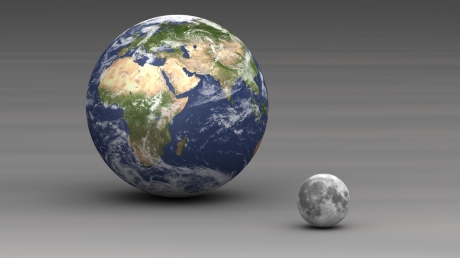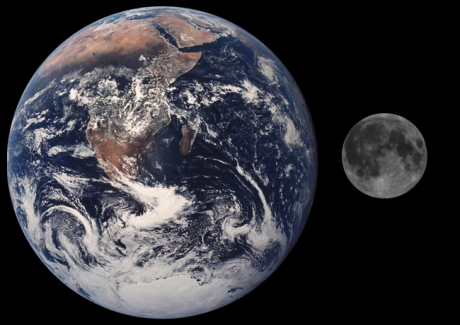Venus, Mars and the Moon February 21, 2015
Posted by WorldbyStorm in Astronomy, Science.4 comments
Yesterday, today and tomorrow those three will appear very close in the sky. Caught this last night, an amazing sight through binoculars. The dot above and very very slightly to the right of Venus is Mars and through binoculars is clearly red in colour.
Jupiter Rising December 20, 2014
Posted by WorldbyStorm in Astronomy, Science.add a comment
I’ve swiped the image below from this blog here because it’s almost precisely what I saw yesterday morning through binoculars of Jupiter and attendant Galilean moons, albeit the four moons visible were ranged left, as it were, of the planet. I’d noticed the planet in the early morning sky, around 7.30, and wondered what it was. The disk was visible through the binoculars and then I saw the moons. It looked almost structural, but a moments googling revealed its identity. As the author of the blog linked to above notes…
On one hand, you’re not going to see any detail on the planet. And the four Galilean moons will just be little sparks.
On the other hand–the hand you should be concentrating on–you went to the closet, knocked the dust off whatever binoculars you already had, pointed them at that bright star over there, and now you can see that it is visibly a planet (despite being almost half a billion miles away) and, oh yeah, those little sparks are moons. If you’ve never seen this before with your own eyes, you will have an emotional reaction.
That’s a brilliant way of putting it. It’s quite something.
Dark skies…over Southwest Kerry February 1, 2014
Posted by WorldbyStorm in Astronomy, Science.9 comments
Some good news for sky watchers…
A 700sq km area in southwest Kerry is expected to be named an international “dark sky reserve”, securing the highest designation for the exceptional quality of its night sky.
It will be the first region in Ireland to receive such an award and – if it achieves “gold-tier” reserve status – the first region in the northern hemisphere to get this designation, spawning hopes for an astro-tourism spin-off.
Scale October 26, 2013
Posted by WorldbyStorm in Astronomy, Science, Uncategorized.10 comments
It’s odd, it’s only in the last few months that I realised just how small the Moon is in relation to the Earth. Sure, I knew it was smaller, but I hadn’t thought about that fact in any detail probably in decades. If you asked me how much smaller I’d probably have guestimated somewhere about somewhere less than an half and greater than a third the size diameter (see comments) of the Earth. But no, the Moon is considerably smaller than that again.
How much? Well, look at these images here, about or a little less than a quarter the diameter.
And that’s interesting because recently looking at the Shadow of the Moon documentary, and this is probably what unconsciously sparked my thoughts in this direction, it seemed to me that the journey from the Command Module to the surface of the Moon seemed quite short. Very short. And it probably was, even accounting for editing, because the Moon has a surface area about that of Asia. Indeed look again at the image above and you’ll see that set up against the Earth (let’s not try that experiment for real – eh, folks?) it would be about as ‘high’, as Africa.
But that sparks a further thought. How far away is it? Well, the easy answer is that it’s … of course it is. But let’s think about that in more human terms of scale. Here’s the ever excellent Phil Plait’s Bad Astronomy blog and a post on just this matter.
If the Earth is the size of a basket ball and the Moon a tennis ball, and the ratio is more or less spot on, more rather than less I hasten to add, then the Moon would be 24 feet away! That’s quite a distance. There’s a bunch of videos on YouTube that show what other planets would look like if they were orbiting the Earth at the same distance as the Moon. I can’t say how accurate they are, some are probably there or thereabouts.
But as Plait says:
I’m sometimes asked what’s the one thing I wish people would understand better about the Universe. My answer is always the same: scale. We humans have a miserable sense of just how big space is, and I’ve spent a lot of time over the years working out ways to express it better.
And:
Space is big. Very, very big.
And using the same scale Plait makes a very thought provoking point. How far away is the nearest star from Earth?
It would be — to scale, mind you — 800,000 km (480,000 miles) away: twice as far as the real Moon is from the real Earth!
I’ve been thinking a lot about the prospects for human interstellar travel, and I’m moving to a position where I wonder if sheer scale is just too great a challenge, at least for the foreseeable future. Humans are notoriously bad at future planning, and there’s no proof that our artefacts can survive the sort of time spans required. Add those together and the lack of viable technologies and the future looks… isolated.
Charles Stross deals with this issue here… and funnily enough Robert Silverberg in the current edition of Asimov’s raises the point in a slightly different context.
Where are the Voyager space craft now? July 27, 2013
Posted by WorldbyStorm in Astronomy, Culture, Science.1 comment so far
<I want a proper diagram updated in real time! Does anyone know of one?
A glancing blow… May 18, 2013
Posted by WorldbyStorm in Astronomy, Science.1 comment so far
…is expected from a Coronal Mass Ejection from the sun which occurred when four massive X-class solar flares were produced on Monday. The CME’s from three didn’t move in the direction of this planet, but the fourth did and that will impact in that ‘glancing blow’ today with the Earth’s magnetic field.
Also causing temporary radio blackouts, AR1748 is likely not finished. Still forecast to have a significant chance of producing strong flares, the active region is rotating into more direct view across the Sun’s nearside.
Good to know.
Cosmophilia December 21, 2012
Posted by WorldbyStorm in Astronomy, Science.add a comment
Here’s Phil Plait’s best astronomy images of of the year on Slate. It is a genuinely amazing universe out there… look at ‘Rotating Gas Cloud’ for perhaps the most amazing. But then again they’re all good.
Cosmophobia… December 21, 2012
Posted by WorldbyStorm in Astronomy, Culture, Science, Uncategorized.12 comments
This has to be the most depressing aspect of the recent stuff about Mayan apocalypse (and in truth was ever a people so traduced after the fact in terms of the contemporary nonsense about their supposed predictions? They should sue.). On this fact sheet produced by the SETI Institute to assure people all will be well there’s the following:
Cosmophobia: Many young people write to me that they are scared of astronomy. When they read about some new discovery, the first thing they think is that it might hurt them, even if it is happening in a distant galaxy. There is no reason for such fears, which I call cosmophobia (fear of the universe). This rash of concern seems to be the result of too many conspiracy theories and sensational stories featured on the Internet and irresponsible news outlets. Astronomical objects are so distant that they cannot threaten the Earth. Please don’t be afraid of the Sun or the planets or comets or asteroids. The universe is not your enemy.
Though this from Voyager 2’s twitter feed is sort of funny, appearing early this morning (and reported on the Guardian’s liveblog):
END MAYACAL BTUN 12.19.19.17.19 SHUTDOWN:UNIV(12) BEGIN BTUN 13.0.0.0.0 BOOT:UNIV(13)
Bits and pieces… December 15, 2012
Posted by WorldbyStorm in Astronomy, Culture, Libertarianism, Science, Uncategorized.6 comments
This is odd, assuming it’s accurate. Glenn Beck made a piece of parodic ‘art’ which has a figure of Obama in what is supposedly urine, a play on the famous Piss Christ work by Andres Serrano. Problem is that this can’t function in the way Beck seems to think it will, i.e. enraging Democrats and US liberals. It’s simply not the same dynamic – few would consider Obama as being equivalent to a deity (and truth is I’ve often wondered how many people were genuinely upset by Piss Christ in the first place) – perhaps not even the same import given that it is essentially unserious (and Beck seems to say that it beer not urine). Still, it is oddly interesting as an example of pretty poor trolling (I’d say on an epic scale, except somehow although that might be the intent it is not the actuality). You’d have to worry about the man. Sort of.
This is for all those who think well of Carl Sagan…
http://vimeo.com/51960515
I’ve already referenced the ‘Pale Blue Dot’ here, and I’m not sure whether I’m pleased or appalled that there’s something of a cottage industry on YouTube producing animations and videos to go along with the text he recorded above – a sort of secular humanist prayer as it were.
Continuing matters astronomical, what of this from wiki about Patrick Moore where it is claimed that he played ‘Anarchy in the UK’ on xylophone at a Royal Variety performance. Hard to believe. Here though from Room 101 is Moore doing something not entirely dissimilar with Jon Culshaw.
Interested in Objectivism? Or are you an Objectivist? Or do you know one? Here’s a site focussed on all things Rand.
Reading through it I found a piece on Bioshock, the computer game, which I’d forgotten has an Objectivist back story. Though it’s not entirely complimentary to the philosophy. Hmmmm…
Patrick Moore 1923 – 2012 December 9, 2012
Posted by WorldbyStorm in Astronomy, Culture, Science.5 comments
…as noted in comments here. A complex person, clearly a leading light in the field of astronomy (but as evidenced in interviews with the ability to make some particularly reactionary statements at times and to champion, and quite actively too, some very reactionary causes). Yet of huge significance, and value, as a key populariser of astronomy (and the author of a range of juvenile SF novels which I recall, at this distance as being not bad at all). And also to his credit a populariser who didn’t dumb down.




